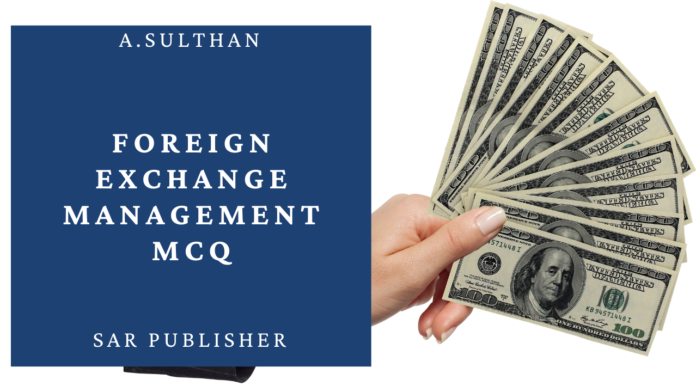Foreign Exchange Management MCQ Questions and Answers Part – 1
Foreign Exchange Management MCQ Questions and Answers Part – 2
Foreign Exchange Management MCQ Questions and Answers Part – 3
1. Foreign exchange transactions involve monetary transactions
A. among residents of the same country
B. between residents of two countries only
C. between residents of two or more countries
D. among residents of at least three countries
ANSWER: B
2. Under FEMA, the RBI has been authorised to make —— to carry out the provisions of the Act.
A. rules
B. regulations
C. both rules and regulations
D. notifications
ANSWER: B
3. A foreign currency account maintained by a bank abroad is its
A. nostro account
B. vostro account
C. loro account
D. foreign bank account
ANSWER: A
4. ‘Non-resident Bank Accounts’ refer to
A. nostro account
B. vostro account
C. accounts opened in offshore centres
D. none of the above
ANSWER: B
5. Non-resident bank accounts are maintained in
A. the permitted currencies
B. the currency of the country of the bank maintaining the account
C. the currencies in which FCNR accounts are permitted to be maintained
D. Indian Rupee
ANSWER: D
6. The statutory basis for the administration of foreign exchange in India is
A. Foreign Exchange Regulation Act, 1973
B. Conservation of Foreign Exchange and Prevention of Smuggling Act.
C. Foreign Exchange Management Act, 1999
D. Exchange Control Manual
ANSWER: C
7. Full fledged money changers are authorized to undertake
A. only sale transactions
B. only purchase transactions
C. all types of foreign exchange transactions
D. purchase and sale of foreign currency notes, coins and travellers cheques
ANSWER: D
8. The acronym FEDAI stands for
A. Foreign Exchange Dealers’ Association of India
B. Federal Export Dealers’ Association of India
C. Fixed Earners’ Draft Agreement on Interest
D. None of the above
ANSWER: A
9. An authorised person under FEMA does not include
A. an authorised dealer
B. an authorised money changer
C. an off-shore banking unit
D. an exchange broker
ANSWER: D
10. The authorised dealers under FEMA are classified into —– categories
A. Three
B. one
C. two
D. four
ANSWER: A
11. The term ‘loro account’ means
A. our account with you
B. your account with us
C. their account with them
D. none of the above
ANSWER: C
12. The term ‘Nostro account’ means
A. our account with you
B. your account with us
C. their account with them
D. none of the above
ANSWER: A
13. The term ‘Vostro account’ means
A. our account with you
B. your account with us
C. their account with them
D. none of the above
ANSWER: B
14. The market forces influencing the exchange rate are not fully operational under
A. floating exchange rate system
B. speculative attack on the market
C. fixed exchange rate system
D. current regulations of IMF
ANSWER: C
15. According to classification by IMF, the currency system of India falls under
A. managed floating
B. independently floating
C. crawling peg
D. pegged to basked of currencies
ANSWER: A
16. Under a fixed exchange rate system, the currency rate in the market is maintained through
A. official intervention
B. rationing of foreign exchange
C. centralising all foreign exchange operations with the central bank of the country
D. none of the above
ANSWER: A
17. The reduction in the value of a currency due to market forces is known as
A. revaluation
B. depreciation
C. appreciation
D. inflation
ANSWER: B
18. The largest foreign exchange market in the world is
A. Newyork
B. London
C. Japan
D. Swiss
ANSWER: B
19. Foreign exchange market is considered 24 hours market because
A. it is open all through the day
B. all transactions are to be settled within 24 hours
C. due to geographical dispersal at least one market is active at any point of time
D. minimum 24 hours must elapse before any transaction is settled
ANSWER: C
20. The major players in the foreign exchange market are
A. commercial banks
B. corporates
C. exchange brokers
D. central bank of the country and the central government
ANSWER: A
21. Speculation in the foreign exchange market refers to
A. buying or selling of currencies in large volumes
B. booking of forward contracts without intention to execute
C. buying or selling with a view to make profits from movement in rates
D. buying or selling with a view to making riskless profits.
ANSWER: C
22. Arbitrageur in a foreign exchange market
A. buys when the currency is low and sells when it is high
B. buys and sells simultaneously the currency with a view to making riskless profit
C. sells the currency when he has a receivable in future
D. buys or sells to take advantage of market imperfections
ANSWER: B
23. The acronym SWIFT stands for –
A. Safety Width in Financial Transactions
B. Society for Worldwide International Financial Telecommunication
C. Society for Worldwide Interbank Financial Telecommunication
D. Swift Worldwide Information for Financial Transactions
ANSWER: C
24. Indirect rate in foreign exchange means –
A. the rate quoted with the units of home currency kept fixed
B. the rate quoted with units of foreign currency kept fixed
C. the rate quoted in terms of a third currency
D. none of the above
ANSWER: A
25. Indirect rate of exchange is quoted in India for –
A. sale of foreign travellers cheque
B. sale of rupee travellers cheques
C. purchase of personal cheques
D. none of the above
ANSWER: D
26. In direct quotation, the unit kept constant is –
A. the local currency
B. the foreign currency
C. the subsidiary currency
D. none of the above.
ANSWER: B
27. The maxim ‘buy low; sell high’ is applicable for –
A. quotation of pound-sterling
B. indirect rates
C. direct rates
D. US dollars
ANSWER: C
28. In Mumbai, US Dollar is quoted as under: USD 1 = Rs.43.6725/6875. It means-
A. The buying rate is Rs.43.6725 and the selling rate is Rs.43.6875.
B. The buying rate is Rs.43.6875 and the selling rate is Rs.43.6725
C. The dollar is appreciating in value.
D. The dollar is depreciating in value
ANSWER: A
29. In foreign exchange markets, ‘American Quotation’ refers to-
A. quotation by a US-based bank
B. quotation in New York foreign exchange market
C. quotation in which the value of foreign currency is expressed per US dollar.
D. quotation in which the value of the US dollar is expressed per unit of foreign currency
ANSWER: D
30. Forward margin is-
A. the profit on forward contract
B. commission payable to exchange brokers.
C. difference between the spot rate and forward rate
D. none of the above
ANSWER: C
31. In the following quote: Spot USD 1 = Rs.45.6500/650 Spot September 100/150 September forward buying rate for dollar is –
A. Rs.45.6800
B. Rs.45.6600
C. Rs.45.7500
D. Rs.45.6500
ANSWER: B
1/23/2020 172.16.1.50/printqp.php?heading=PGDIB [2019-2020], SEMESTER II, CORE : FOREIGN EXCHANGE MANAGEMENT – 281A&qn…
172.16.1.50/printqp.php?heading=PGDIB [2019-2020], SEMESTER II, CORE : FOREIGN EXCHANGE MANAGEMENT – 281A&qname=281a 5/19
32. the transaction where the exchange of currencies takes place two days after the date of the contract is
known as
A. ready transaction
B. value today
C. spot transactions
D. value tomorrow
ANSWER: C
33. The transaction where the exchange of currencies takes place on the same date is known as
A. tom
B. ready transaction
C. spot transactions
D. value tomorrow
ANSWER: B
34. A transaction in which the currencies to be exchanged the next dayof the transaction is known as
A. ready transaction
B. value today
C. spot transactions
D. Value tomorrow
ANSWER: D
35. The transaction in which the exchange of currencies takes place at a specified future date, subsequent to the spot date is known as a
A. swap transaction
B. forward transaction
C. future transaction
D. non-deliverable forwards
ANSWER: B
36. One month forward contract entered into on 22nd March will fall due on
A. 21th April
B. 22nd April
C. 23rd April
D. 24th April
ANSWER: D
37. The buying rate is also known as the
A. bid rate
B. offer rate
C. spread
D. swap
ANSWER: A
38. The selling rate is also known as
A. bid rate
B. offer rate
C. spread
D. swap
ANSWER: B
39. The difference between buying rate and selling rate is the gross profit for the bank and is know as the
A. bid rate
B. offer rate
C. spread
D. swap
ANSWER: C
40. Direct quotation is also known as
A. home currency quotation
B. foreign currency quotation
C. currency quotation
D. American quotation
ANSWER: A
41. In direct quotation the principle adopted by the bank is to
A. buy low only
B. buy low; sell high
C. buy high; sell low
D. sell low only
ANSWER: B
42. In indirect quotation the principle adopted by the bank is to
A. buy low only
B. buy low; sell high
C. buy high; sell low
D. sell low only
ANSWER: C
43. Indirect quotation is also known as
A. home currency quotation
B. foreign currency quotation
C. European quotation
D. American quotation
ANSWER: B
44. Derivatives can be used by an exporter for managing-
A. currency risk
B. cargo risk
C. credit risk
D. all the above
ANSWER: A
45. The term risk in business refers to-
A. chance of losing business
B. chance of making losses
C. uncertainty associated with expected event leading to losses or gains
D. threat from competitors
ANSWER: C
46. Under the forward exchange contract-
A. the exchange rate is determined on the future date
B. the parties agree to meet at a future date for finalisation
C. delivery of foreign exchange is done on a predetermined future date
D. none of the above
ANSWER: C
47. The bank should verify the letter of credit/sale contract for booking a-
A. forward sale contract
B. forward purchase contract
C. cancelleing a forward contract
D. none of the above
ANSWER: B
48. Normally forward purchase contract booked should be used by the customer-
A. for executing the export order for which the contract was booked
B. for any export order from the same buyer
C. for any export order for the same commodity
D. for any export order
ANSWER: A
49. A currency future is not
A. traded on futures exchanges
B. a special type of forward contract
C. of standard size
D. available in India
ANSWER: D
50. Which of the following statements is true?
A. Exchange exposure leads to exchange risk
B. exchange risk leads to exchange exposure
C. exchange exposure and exchange risk are unrelated
D. none of the above
ANSWER: A


